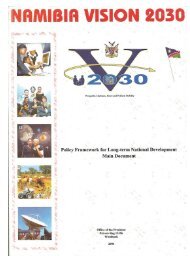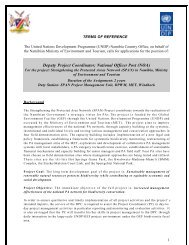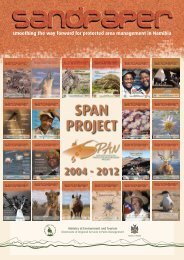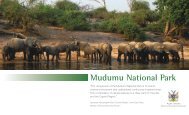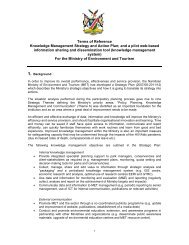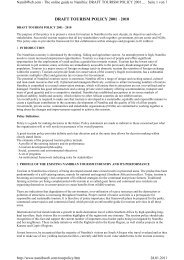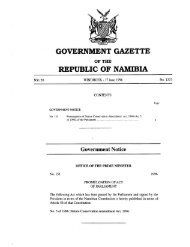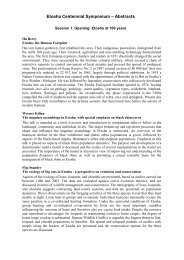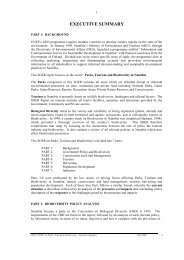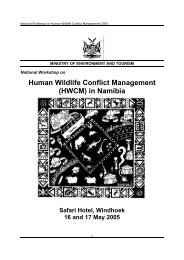Waterberg Plateau Park - Ministry of Environment and Tourism
Waterberg Plateau Park - Ministry of Environment and Tourism
Waterberg Plateau Park - Ministry of Environment and Tourism
You also want an ePaper? Increase the reach of your titles
YUMPU automatically turns print PDFs into web optimized ePapers that Google loves.
Discover the <strong>Waterberg</strong> <strong>Plateau</strong> <strong>Park</strong><br />
Over 150 million years ago, dinosaurs roamed the plateau at <strong>Waterberg</strong>.<br />
Now you can too, <strong>and</strong> discover the amazing variety <strong>of</strong><br />
plant <strong>and</strong> animal life that thrives here today. Rising some 200<br />
metres above the surrounding African savannah, the <strong>Waterberg</strong><br />
<strong>Plateau</strong> with its brilliant brick-red s<strong>and</strong>stone formations <strong>and</strong><br />
lush green vegetation is a wonderous place to explore. Take on<br />
the challenge <strong>of</strong> a three-day hike, accompanied by a park ranger,<br />
to the <strong>Waterberg</strong>’s summit, or the thrill <strong>of</strong> setting out on your<br />
own 42-km self-guided trail. Catch a glimpse <strong>of</strong> an illusive leopard<br />
or patiently stalk a herd <strong>of</strong> sable through the dense bush.<br />
Visit the Vulture Restaurant, a conservation effort designed to<br />
attract hundreds <strong>of</strong> vultures, including Cape vultures, where they<br />
feast. Guided game drives on the plateau, plus time spent in a<br />
hide lying in wait for rare species to approach a waterhole, give<br />
you the chance to learn more about one <strong>of</strong> the most unique<br />
conservation areas in the world.<br />
A natural fortress for conservation<br />
The <strong>Waterberg</strong> <strong>Plateau</strong> <strong>Park</strong> is not only an isl<strong>and</strong> <strong>of</strong> vibrant colour<br />
<strong>and</strong> biodiversity; it presents a natural opportunity for conservation.<br />
The park was initially proposed to protect el<strong>and</strong>, Africa’s<br />
largest antelope, but, recognising the natural physical defences<br />
<strong>of</strong> the plateau against human <strong>and</strong> livestock encroachment, conservationists<br />
soon introduced other endangered animals in an<br />
effort to establish protected breeding populations. Black <strong>and</strong><br />
white rhinoceros, Cape buffalo, <strong>and</strong> tsessebe, sable <strong>and</strong> roan antelope<br />
have all been reintroduced onto the <strong>Waterberg</strong> <strong>Plateau</strong>.<br />
These species are on the increase <strong>and</strong> surplus populations are released<br />
regularly in other protected environments. State-<strong>of</strong>-theart<br />
game bomas have been constructed, in which captured animals<br />
are held prior to auction <strong>and</strong> relocation. The Game Products<br />
Trust Fund (GPTF) ploughs pr<strong>of</strong>its from the auctions back into<br />
conservation. Poaching has been eliminated, <strong>and</strong> the <strong>Waterberg</strong><br />
<strong>Plateau</strong> <strong>Park</strong> st<strong>and</strong>s as a natural fortress for conservation.



